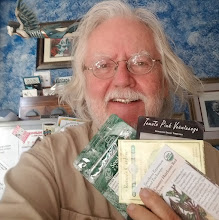 |
| A Monarch butterfly larva feeds on a plant with adult lady bugs in the background. |
I often get calls about which insecticide should be used on which insect and I always wonder about the folks who ask me these questions because they obviously don't know me that well; if they did they would also know I haven't used an insecticide in over eight years!
I am convinced we have to spray insecticides, because we have sprayed insecticides to begin with. Mind you, when I became the Gardenmaster at the Learning Garden, I did not embrace the restriction of no insecticides, and tried to skirt the rules, but as the garden thrived without insecticidal use, I began to have courage no insecticide use was possible. It's now my personal rule: no pesticides.
When
we spray, even with the most benign insecticides, we probably kill
more 'good insects' than bad. With aphids on your plants, all other
things being equal, a lady bug or another beneficial species has probably already laid eggs near-by so the larvae, when they hatch
out, can feed on those 'bad bugs.' Spraying probably kills the good
guys faster than the bad.
If you are using 'organic' insecticides, you are using the WORST insecticides because they are non-specific insecticides – meaning they kill whatever they touch. They are 'better insecticides' only in that they don't persist in the garden, but make no mistake, they are lethal to insects of all kinds as long as they are wet. (Point of fact, California law regulates when you can spray insecticides to early morning and early evening. If you ignore my pleas and spray anyway, please ONLY spray in the evening when honey bees have returned to their hives so you at least will not kill them! We already have a crises in honey bee populations, please do not make it worse.)
If you are using 'organic' insecticides, you are using the WORST insecticides because they are non-specific insecticides – meaning they kill whatever they touch. They are 'better insecticides' only in that they don't persist in the garden, but make no mistake, they are lethal to insects of all kinds as long as they are wet. (Point of fact, California law regulates when you can spray insecticides to early morning and early evening. If you ignore my pleas and spray anyway, please ONLY spray in the evening when honey bees have returned to their hives so you at least will not kill them! We already have a crises in honey bee populations, please do not make it worse.)
Something
I didn't realize until recently became the coup de grâce in
my anti-insecticide stance: all these poisons go into the ground –
when you spray, you spray to cover the plant and the stuff you spray
goes 'drip-drip-drip' into the soil. What does it do to the critters
in the soil? I don’t know but I'll bet you a cup of coffee it
isn't pretty. I'm striving to have a LOT of critters in my soil
because that is the way to real fertility (we do not use any fertilizers in our garden either). It is my bet that if pesticides don't actually kill of the beneficial soil
organisms, they at the very least impact them in a negative manner and diminish their
productivity.
Lately I've come to see that mostly insects only attack weak plants – the exception to this is that insects will also attack seedlings even if they are grown optimally. To deal with that, I use a barrier between the harmful insects and the plants until the plants are big enough to fend for themselves
There are those plants the insects 'get' and there seems to be no way to save them. I have come to feel that this is natures way of removing a given plant's genetic make up from the pool – for some reason this plant was not thriving and nature has decided, in her inscrutable manner, to remove this plant before it can replicate. So be it! I can yank it and afford more room for a plant that doesn't need to be sprayed.
Remember, pristine produce, like what you see on the shelf of the supermarket, is an artificial creature placed before you in the interest of divorcing you from reality. Real food often has evidence that it is good to eat; it's approved by other species. This stuff we have come to think of as 'normal' comes to our table with a tremendous price tag on the environment and the other critters on this planet.
So when you use pesticides – especially organic pesticides – you are left with dead soil critters that make your soil more fertile and you've killed off the beneficial insects. At the Learning Garden, our plants may have hole or two, or show other evidence of being nibbled. It's good. It shows we are organic and it proves we are committed to a world without gratuitous violence to other species. In ten years, I have lost two crops to insects. One was my own fault for trying to get muskmelons to grow in an area with too much shade. They succumbed in short order. The next time I lost a crop, it was a lot harder to take: flat after flat of broccoli, cauliflower, cabbage and kale, something like 8 or 9 flats in all, were mowed down just after coming out of the ground by the cabbage looper. This is the white moth you see aimlessly flying thither and yon on a lazy, uninspired flight. Often considered a white 'butterfly,' this creature lays eggs near a cabbage family seedling and the hatchling 'worm' proceeds to defoliate the little seedlings to the point they cannot survive (mind you once the plants are larger, these larvae can munch all they want and it will not kill the plant so I have no concern by then).
Remember, pristine produce, like what you see on the shelf of the supermarket, is an artificial creature placed before you in the interest of divorcing you from reality. Real food often has evidence that it is good to eat; it's approved by other species. This stuff we have come to think of as 'normal' comes to our table with a tremendous price tag on the environment and the other critters on this planet.
So when you use pesticides – especially organic pesticides – you are left with dead soil critters that make your soil more fertile and you've killed off the beneficial insects. At the Learning Garden, our plants may have hole or two, or show other evidence of being nibbled. It's good. It shows we are organic and it proves we are committed to a world without gratuitous violence to other species. In ten years, I have lost two crops to insects. One was my own fault for trying to get muskmelons to grow in an area with too much shade. They succumbed in short order. The next time I lost a crop, it was a lot harder to take: flat after flat of broccoli, cauliflower, cabbage and kale, something like 8 or 9 flats in all, were mowed down just after coming out of the ground by the cabbage looper. This is the white moth you see aimlessly flying thither and yon on a lazy, uninspired flight. Often considered a white 'butterfly,' this creature lays eggs near a cabbage family seedling and the hatchling 'worm' proceeds to defoliate the little seedlings to the point they cannot survive (mind you once the plants are larger, these larvae can munch all they want and it will not kill the plant so I have no concern by then).
If
there is only a small infestation, comb the plans for this larval,
little green worm which you have my permission to squash in your fingers or fling to
the ground to be stepped on. In this, you're are only killing
the target insect. Mind you, I'm not in favor of letting all bugs live! It's just we kill far too many of the wrong
species.
 |
| While at the same time, a few feet away, an adult Monarch rests on a California Matiliha Poppy |
To
bear me out, the one acre garden at Venice High School, The Learning
Garden, doesn't lose a lot of plants to pests – yet we do not
spray ANY pesticides, organic or otherwise. On the other hand, bees,
wasps, butterflies and a hosts of other critters live in our garden
and make their home here. This is as it should be, no? Spraying for
aphids would impact our butterfly populations and frankly, I am so
buoyed by the multitude of Monarchs gracefully fluttering through
our garden that I would give up considerably more than a few poisons
to keep them here.
So
don't ask me what I would spray on your insects. I wouldn't spray a
thing.
david






.jpg)